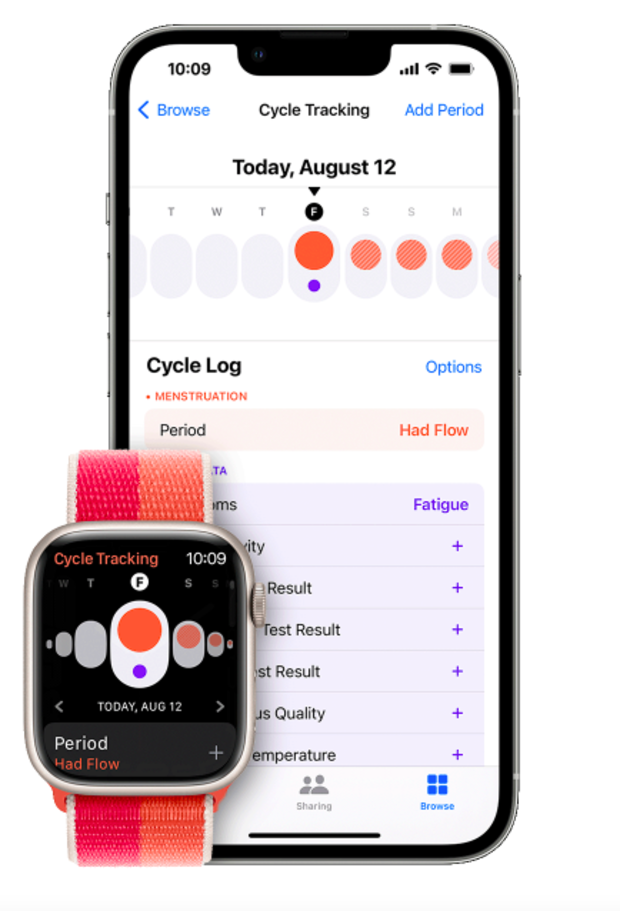'I Use Apple's Cycle Tracking to Monitor My Periods—This Feature Is Why It's Better Than Other Apps'
No one wants to be that person who gets her period in the middle of dinner with a friend only to realize that she doesn't have a single tampon in her bag, but for a few months, that was me.
It's not that I had failed to prepare, it was that I truly had no idea when to expect my period. As someone with a very regular cycle, after having a miscarriage last year, I suddenly found that my periods were as unpredictable as spring weather: I had a few periods that were 21 days apart (what?) and then two that were 32 days apart.
As Parade's Health Editor, I know quite a bit about how to use apps to get the health-related information I need. So I started downloading as many period-tracking apps as I could in hopes of putting an end to this whole surprise-period thing. But it wasn't until my Apple Watch prompted me to use Apple's Cycle Tracking App that I actually started getting accurate estimates of when my period would arrive. Here's what makes the Apple Watch such a great period-tracking device.

Courtesy Leigh Weingus
How Apple's Cycle Tracking App Works
Most cycle-tracking apps collect data based on what you report to them. You let them know when your last period started, when it ended and then input that same information when the next cycle rolls around. With this information, your app starts to get a general idea of how long your cycles are and gives you estimates based on that.
Of course, this wasn't really working for me, because my periods were erratic. How could one of these apps possibly give me an accurate estimate when my cycles varied so drastically?
Related: Do Period Tracker Apps Work?
In a lot of ways, Apple's cycle tracking system isn't very different from the other apps I'd used. It prompted me to input when a period started, when it ended and when the one after that started. It gives you the option to record your flow (Light? Heavy? Spotting?) and gives you both a fertile window and period estimate.
But one month into using it, I started getting notifications that said, "Based on data collected from your Apple Watch, your expected period date has shifted." This was new, and to my surprise, I realized Cycle Tracking was actually right: I tended to get my period right around when the app predicted I would!

Apple
Fascinated by this discovery, I started reading up on it and learned that my watch was using my heart rate data to determine everything from my fertile window (or when I would ovulate) to when my period would arrive. According to research, your heart rate is lowest during your period, and slowly rises as ovulation approaches, only to dip back down when you get your period again.
I also learned that the Apple Watch has a feature where you can actually record your basal body temperature while you sleep, which further improves predictions. I never actually had to do that, though, because the predictions given to me based on my heart rate tend to be correct.
Related: Wait—Do You Actually Gain Weight on Your Period?
What Cycle Tracking Looks Like for Me Now
I am happy to report that my periods are finally back in their regular 28-30 day pattern (cue my sigh of relief), but I haven't stopped monitoring my cycle with Cycle Tracking. After my first irregular periods since my teenage years, I'm pretty traumatized by getting my period completely out of the blue, and I'm determined to make sure that never happens again.
Related: Best Fitness Trackers for 2023
While I do think other period-tracking apps are great for people with regular cycles, they can present a challenge for anyone who deals with unpredictability. I love that my Apple Watch not only takes out the guesswork for me but does it in a way that's really easy for me. I don't have to take my temperature or pee on any ovulation sticks, I can just sit around and let it track my heart rate and let me know when my period is coming up. Sounds pretty great, right? On the flip side, if Apple collecting this kind of private data from you freaks you out, worry not: You can turn this feature off, so it won't collect heart rate data as it relates to your cycle.

Apple
And while I'm skeptical of the natural birth control method—the human body is weird, and sometimes we ovulate at unexpected times!—I think using your Apple Watch to track your cycles is one of the better methods for getting an accurate read on when you're actually ovulating. Apparently, our heart rates just don't lie.
